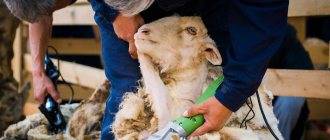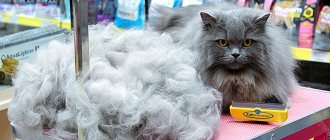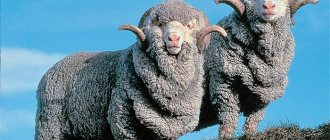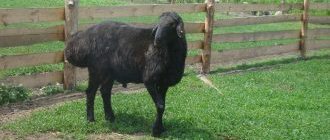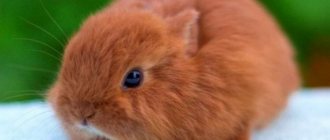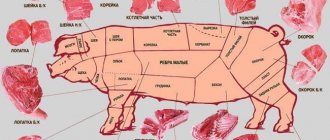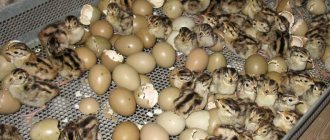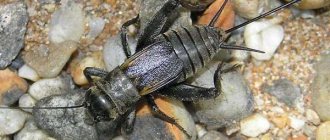Haircut season
The season for manipulation to remove excess wool from sheep will depend on several main factors. The first is the breed of the animal. Depending on whether the artiodactyl belongs to a particular variety, the fur will grow during the year at different rates:
- fine-fleece - 6–9 cm;
- semi-fine-fleece - 6–25 cm and even more;
- coarse-haired and semi-coarse-haired - 15–30 cm.
It is the length of the coat that mainly determines the timing of shearing. In accordance with these indicators, the first 2 groups are trimmed once a year - in the spring . The second 2 groups are cut 2 times a year - in spring and autumn . The Romanov breed has to be cut 3-4 times a year.
The next factor that determines the timing of manipulation is the age of the sheep. Thus, fine-fleece and semi-fine-fleece lambs born in January-February will grow a coat 4–5 cm long by autumn. Shearing is carried out before winter only for lambs that are scheduled for slaughter. Those animals that remain for rearing and will spend the winter are not sheared in the fall, otherwise the young animals will not be able to survive the cold. Lambs of coarse-haired and semi-coarse-wooled breeds are shorn at the age of 4 months for the first time.
Important! In coarse-haired and semi-coarse-haired breeds, natural shedding begins in the spring, so shearing must be done before it begins if you plan to further use it in production. But even if the moment of trimming is missed, shearing must be carried out, otherwise the rams will suffer from the heat and will stop growing.
Another factor is the climatic conditions of the region in which the flock is kept . In the southern regions, tonsure is carried out in April, in the middle zone and northern latitudes the procedure is postponed until mid-to-late May.
Video “Speed shearers of Kalmykia”
In our story we offer to see how shearers from Kalmykia can quickly shear sheep.
Find out more
Products made from sheep wool should be in every home!
How should we name the children of sheep?
Leading countries in global sheep production
Preparatory activities
One of the important activities in preparation for tonsure is keeping your pets clean. The process is greatly complicated by clogging of wool with feather grass and burdock seeds. In addition, this significantly reduces the quality of raw materials. Throughout the entire season, from shearing to shearing, you need to comb out the sheep, and in winter, do not use sawdust as bedding in the sheepfold; it is better to use hay for this purpose.
12–14 hours before the manipulation, you need to keep the flock on a starvation diet to prevent death from volvulus. During this time, the animals' intestines will be free of feces, which will make shearing much easier.
The site for the manipulation must be prepared in advance. To do this, it is better to choose an open area on the street, protected from the wind, clear it of debris and cover it with a tarpaulin. You can carry out manipulations indoors. The main thing is that it is well lit.
Did you know? Sheep are a type of animal with rectangular pupils, which is quite rare among mammals.
Lambs must first be separated from their queens. Children must be kept separately until the end of the event. If you are going to cut animals for the first time, you need to find yourself an assistant.
External links [edit]
| Wikimedia Commons has media related to Sheep shearing . |
- Golden scissors
- World Haircutting Championships
- Walter Bowen
- FarmingAds How to shear a sheep
[1] Sheep shearing information, training, competitions, world shearing records, world shearing championships.
- 'sheep shearing, sheep shearing, sheep shearing, sheep shearing, sheep shearing, sheep shearing, shearing, shearing, sheep shearing, sheep shearing, sheep shearing, super shearing, sheep shearing'. www.shearingworld.com
. Retrieved April 10, 2022.
Methods
There are 2 ways to shear sheep:
- manual;
- machine.
On farms that keep a small number of sheep, the first method is mainly used; for industrial farms, the second method is more suitable, since manual shearing is highly energy-intensive and time-consuming.
Did you know? After birth, lambs are able to recognize their mother by her voice.
Hand cutting
It involves the use of special scissors (as in the picture), which allow you to conveniently position your hand. The manipulation is not carried out quickly, but with high quality. Plus, the blades are positioned so that the risk of injury to animals is minimal.
Machine
Involves the use of mechanized equipment. With its help the process goes much faster. If manual shearing is used only on small farms, then mechanized shearing can be carried out for any number of sheep.
Methods: by hand or by machine
Sheep can be sheared in two ways:
- manual (special scissors are used);
- mechanical (hair clipper).
The first method is used on small farms, as it takes longer than cutting with an electric machine. In this case, the risk of injuries and cuts is higher. However, it is valuable because the shearer cuts the wool closer to the skin, which increases its length.
Haircutting with a mechanical clipper greatly facilitates a person’s work, increasing his productivity. The fleece is always cut evenly, there is no overcutting or uncut areas. To do this, the cutting machine is correctly adjusted before the procedure, the edges of the knives are checked and treated with an antiseptic.
How are sheep sheared?
Accounting for animal vulnerability
Both scissors and clippers can cause damage to animals. This risk must be taken into account during the manipulation. So, at the end of the procedure, you should inspect each sheep for cuts.
Existing damage should be lubricated with a solution of creolin or iodine. It is strictly forbidden to sprinkle wound surfaces on the body of animals with earth. This can lead to blood poisoning and the development of tetanus.
Important! Immediately after the haircut, you need to trim the hooves.
Until the wounds heal, they must be regularly examined and treated with disinfectants. Otherwise, blowflies may lay eggs in them, which will cause serious damage to the farm.
To prevent animals from getting injured during grooming, you should not rest your knee on your pet’s stomach, turn them over their back to the other side, or roll them over the edge of the table with their stomach. All these manipulations can lead to peritonitis and death of animals. The fact is that sheep have a very delicate digestive system, and the slightest pressure on the stomach leads to disruption of its functionality.
You need to be more careful when cutting females. It is necessary to cut the abdomen especially carefully so as not to make cuts directly next to the nipples.
How to shear sheep correctly?
We recommend reading our other articles
- The best varieties of red onions
- Grape variety Izyuminka
- The best early varieties of cucumbers
- Cherry variety Lyubimitsa Astakhova
The master must be strong, confident and make precise, clear movements
Sheep shearing is a very difficult process for a beginner, so it is worth learning before risking the integrity of the animal, however, dangerous objects are used for shearing. The master must be strong, confident and make precise, clear movements, otherwise problems will begin. Sheep, in principle, react calmly to shearing (probably this is genetic), but they can smell inept and insecure “hairdressers” a mile away and will not give in or will kick violently. So it is confidence in your own actions that is very important here.
So how to shear sheep? The whole process can be divided into several stages.
- The sheep is placed on a wooden floor or area where shearing will take place and tied (tied). Three legs are usually tied in a cross, but this method makes it difficult to shear the belly, so most specialists simply tie the sheep by one leg and hold the other three themselves. This is not difficult to do when using high wooden flooring.
- It is impossible to say for sure which part of the body to start cutting from. There are no specific rules. You can come across statements that you need to cut your head first; some “hairdressers” start with the side and, making sharp, fast and long movements, go from the neck to the tail and even the legs. But in reality, it all depends on how convenient it is for a person. Not everyone finds it easy to start from the head or the belly. A big role is played by how the sheep lies or sits, which parts of its body are free and which are not. So you need to start from the place that is at hand - the one that first “looks” at the master, only then everything will work out.
- The most difficult moment of shearing occurs on the belly of females - their nipples are located there, and on the scrotum of rams. It is better to shear there with a clipper, since the scissors are very sharp, and if the sheep jerks sharply, disaster will happen.
- Sheep shearing should be done quickly so as not to torment the animal; it is inconvenient for him to be tied or tied! The coat is cut as close to the body as possible, but so as not to damage the skin.
- You cannot go through the same place twice, due to the fact that a cut is formed, which reduces the cost and quality of the fleece. So this is done only as a last resort.
That's basically all science is. It doesn't sound difficult, but in reality you have to deal with a kicking living creature that may not get along with the clippers or clippers - this is worth keeping in mind!
Rules and techniques: sequence of work
Regardless of which equipment was chosen, manual or electric, the technique for carrying out the work will be the same:
- Place the animal on a flat surface on its left side.
- Trim the rump. Walk in the udder area, covering the nipples with your hands. Remove the fur from the inside of the limbs and immediately set aside the raw materials obtained from this area separately.
- In one pass, cut a solid line between the right pair of limbs - move from the back to the front.
- The belly and chest are cut along longitudinal lines, moving from the hind limbs of a ram, from the udder of a female.
- Carefully help the animal rise, lay it on its other side, and secure it.
- Position yourself facing the pet's belly, take it by the left hind leg and cut along the longitudinal line of the croup, moving towards the left shoulder blade.
- Next, cut the lower back, side and withers with continuous longitudinal lines. Perform movements from the side to the spine. Fix the rams so that, under the weight of their own weight, the layers of wool fall to the floor on their own - if only one shearer is working, then you need to use a rope for fixation. It needs to be placed around the body under the front legs so that the animal cannot chew the clamp during the cutting process.
- Help the animal stand up again and place it on its left side. Change your location to be opposite the pet’s belly.
- Trim the croup, right shoulder blade, side and back with continuous longitudinal lines.
- Go to the neck and head. Trim the right side, making passes perpendicular to the ridge. Raising your head, cut the left side of your neck.
- Move the fur away from the sheep and release it outside the pen.
The sequence of work for shearing a sheep:
Important! When cutting with a clipper, do not linger for a long time in one area, otherwise you will end up with a lot of shreds (small hairs up to 1.5 cm long), which will significantly reduce the quality of the fleece.
Links[edit]
- "Earth". Earth
. Richmond: Country Press. March 13, 2008 - Muhl, G. R. (1972). Handbook for wool breeders
. Australian wool board. paragraph 186. - AFP. "Sheep farmers head to World Cup in France". ctvnews
. Retrieved December 27, 2022. - J. T. Killen, "The Wool Industry of Crete in the Late Bronze Age." Yearbook of the British School at Athens, Vol. 59 (1964), pp. 1–15 Publisher: British School of Athens. DOI: 10.1017/S0068245400006031 JSTOR 30103132
- Preparing wool for market entry. item 34, column 3, The Scientific American
, Volume 1, No. 3. published July 16, 1859 File: Scientific American - Series 2 - Volume 001 - Issue 03.pdf - "Chisholm, Alec H." Australian Encyclopedia
.
8
. Sydney: Halstead Press. 1963. p. 86. Haircut. - ^ ab Gilbert, Lionel, New England Readings, Armidale College of Higher Education, Armidale, 1977
- ^ ab Committee on Economic Development and the Current State of the Sheep Industry in the United States, Agriculture and Natural Resources Council, Division of Earth and Life Research, National Research Council (2008). Changes in Sheep Farming in the United States: A Transition from Tradition. National Academy of Press. item 286. ISBN. 0309134390. Retrieved December 29, 2013.CS1 maint: multiple names: authors list (link)
- Court, Jane; Sue Hydes; John Webb-Ware (2010). Sheep farming for meat and wool production. Csiro Publishing. item 183. ISBN. 064310206X. Retrieved December 30, 2013.
- Taylor, Peter, Pastoral Properties of Australia, George Allen and Unwin, Sydney, London, Boston, 1984
- "Bowen Technique". Retrieved August 26, 2008.
- "Sheep Parasites". Archived from the original on December 2, 2008. Retrieved November 10, 2008.
- ↑
Julian Cribb (26 June 1998). "CSIRO Press Release: REVOLUTIONARY WOOL CLEANING IS KILLED". CSIRO. Retrieved August 26, 2008. - Devantier, Alecia T.; Carol A. Turkington (2009). Unusual work with animals. Publishing an information base. paragraph 99. ISBN 1438111703. Retrieved December 29, 2013.
- ↑
Australian Broadcasting Corporation. News as of March 10, 2022 - "Social group targets Australian haircut abuse". Retrieved September 17, 2014.
- "MA000035: Pastoral Prize 2010". awardviewer.fwo.gov.au
. Retrieved August 30, 2022. - ^ab Kat Sullivan, "Union concerned about shearers' abuse of sheep", ABC Rural, 17 October 2013
- ↑
Oliver Millman, "Sheep cruelty video prompts RSPCA investigation",
The Guardian,
10 July 2014. - Colin Bettles, "Shearers not back PETA: No excuse for cruelty," FARMONLINE, July 11, 2014.
- "Knowledge Base: Wool - Australian Farms". www.aussiefarms.org.au
. Retrieved October 25, 2022. - Chesucha, Five Hundred Points of Good Husbandry
, 1557. - Great Vacation Ideas - Relax in Walcha
, Vol. 4 May 2009, The Land, Rural Press, North Richmond, NSW - Sim, Terry; Hough, Cassie (June 10, 2010). "Sparks of a Spectacular Pilgrimage." Earth
. North Richmond, NSW: Rural Press. pp. 16–19. - "Shearer sets records". ABC News Online. March 6, 2007. Retrieved August 26, 2008.
- Golden Scissors 2009 Retrieved on 2009-6-30
- Rattue, Chris (2011). "Star Profile: David Fagan - Shearing - NZ Herald News". The New Zealand Herald
. Retrieved February 27, 2011. - "World Shearing Championships: World Champions Shearing and Wool Processing". www.shearingworld.com
. Retrieved April 10, 2022.
Collection and storage of fleece
The fleece is weighed and laid out on a lattice surface in topographic order (sides, back, legs) with the staples facing up. Then the sheepskin is shaken off dust and dirt. Separate the yellowed areas, frill, pollen, tuft, rump and dung part.
Before storage, raw materials are washed. To do this, prepare a solution of soap and soda - add 100 g of soap and 50 g of soda to 6 liters of hot water (+45...+50°C). The prepared concentrate is combined with 8 liters of water at the same temperature. In this solution, the raw materials are washed three times. Then rinse in clean water, squeeze thoroughly and dry. After drying, place in bales made of natural fabric in a well-ventilated, dry area.
Search for products
Sheep shearing is not a tricky business, and yet if you know the basic rules, you can greatly simplify life for yourself and your sheep. Professionals in industrial wool production conditions shear 20 sheep in 20 minutes (it takes an average of one minute to shear one sheep), but this requires more than one year of practice and the appropriate equipment, which costs money. much money. For small farms (up to 200 heads), these sheep shearing machines are enough.
In this article we will look at the rules and technology of shearing sheep, see how it is done in the photo and of course watch the “ Sheep shearing video ”. If while viewing these materials “sheep shearing video” you have any comments or suggestions, or you want to share your personal experience of shearing sheep, do not forget to express all your thoughts in the comments at the end of the article. Enjoy watching the sheep shearing video !
Care and processing of instruments
Haircutting equipment requires careful maintenance . Otherwise, it will quickly become unusable, and with its further use the risk of cutting animals will increase.
If the haircut is done manually, then after the procedure the scissors should be rinsed with cold water and dried with a towel. Then sharpen thoroughly and lubricate with machine oil. Store in cartons in a dry place to avoid corrosion.
Important! If, when cutting with a clipper, you have to make significant efforts to advance, then the knives should be replaced or taken to a workshop for sharpening.
After using the machine, you should carry out the following manipulations:
- Clean the knives from any remaining lint using a special brush that comes with the equipment;
- wipe all metal parts of the instrument with a soft cloth;
- treat all components with machine oil;
- put the knives in special cases.
Electric tools should be stored in a well-ventilated, dry place and should not be used to trim other animals.
Preparing the premises
Experienced farmers approach this process in advance and with all seriousness. They choose the driest and brightest room, clean it of manure and disinfect it. A prerequisite is the absence of drafts. For grooming, a table is made about 50 cm high, 1.5 m wide and 1.7 m long. It is convenient to place the animal on it, and the wool is protected from contamination. There must be means nearby to treat the animal’s wounds.
If the procedure is carried out outdoors, then an elevated place is selected where there are no drafts. The ground is covered with tarpaulin. If desired, you can make a small canopy from direct sunlight.
Preparing the premises
Recommendations after haircut
The sheep experiences quite a lot of stress during the shearing itself and from being on a starvation diet for a long time. In this regard, for the first 3 days the flock should be allowed to graze on fields of average nutritional value. The fact is that after a hunger strike, an abundance of succulent food can cause bloating.
After removing the fur, climate changes must be monitored very carefully. With sudden changes in temperature, shorn lambs may suffer from hypothermia or sunburn.
In this regard, the herd should not be grazed too far from the sheepfold so that the animals have the opportunity to hide there. In regions with a hot climate, it is better to graze only in the morning and evening during the first month.
Raising sheep involves regular seasonal shearing. To do this, you can choose either manual or mechanized methods. The main thing is to follow the process technology and handle the animals carefully so as not to harm them.
Raising sheep in a stall
Stall farming has a number of differences from pasture farming. It can be called forced. This method is practiced in areas where there is not enough green space. Stall farming has extremely low profitability and a number of other negative factors that make it currently less attractive in Russia than free-range farming. These include:
- Low economic efficiency.
- High incidence of disease in the herd.
- Poor care and maintenance.
- Unnatural conditions for sheep.
The possibility of stall breeding is more relevant in arid areas with dense urban areas. It is typical for Western countries with a different vector of livestock development. There, the housing in the stall is constantly modified and developed.
Reasons for low profitability
- Spending on grains as the main type of feed is increasing.
- Expenses for employee wages, transportation costs, and maintaining appropriate sanitary conditions are sharply increasing.
- A section on the prevention of various diseases is included.
